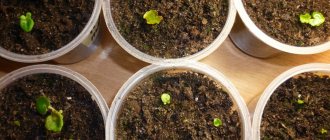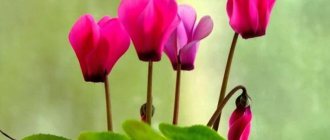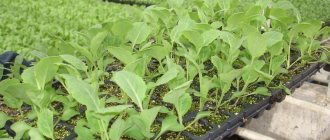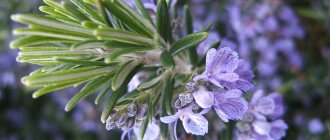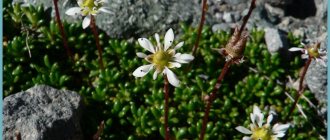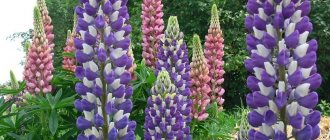Begonia is a perennial flowering plant. Flowers are simple, double, semi-double, of various colors and shades. It blooms from June until frost; in indoor conditions, the flowering period lasts up to 8 months. Does not tolerate negative temperatures.
The ampelous varieties of this plant differ from the usual ones in the direction of growth. The stems grow horizontally and hang down under their own weight in flowerpots or pots. The ampelous characteristics are most pronounced in tuberous and Bolivian begonias; other varieties most often have a bush-like form.
Among flower growers, the most popular series of hanging begonias is “Chanson”. The flowers of plants in this series are double, large, numerous, and of various colors. There are pink, white, yellow, bright red. Two-color begonias look very impressive - pink-white and orange-yellow.
The foliage is highly decorative. The carved, often asymmetrical leaves can be green, burgundy, pink or have several shades.
From planting to flowering it takes from 4 to 6 months, depending on the varietal characteristics and maintenance conditions. In the second year of development, flowering occurs in late February or early March.
Sowing begonia seeds
Growing ampelous begonia from seeds does not involve much difficulty. Unlike many other flowers, ampelous begonia tolerates planting well in the early stages. For full development, 10 hours of lighting per day is enough for her. Therefore, most often sowing begins at the end of January or beginning of February. If it is not possible to provide additional light to the seedlings in the early stages of development, it is advisable to sow later, from mid-February to early March.
Before sowing, you need to prepare: a greenhouse, seeds, soil, and a spray bottle.
Any container covered with transparent material can be used as a greenhouse. It is important to ensure good drainage; waterlogging is dangerous for seedlings.
You need to be careful when choosing seeds. They lose their viability very quickly, especially if stored at room temperature. Therefore, fresh ones are needed for sowing, preferably from last year’s harvest. The seeds are very small and are most often sold coated.
For sowing, light soil, neutral or slightly acidic, is required. Ready-made soil mixtures can be used labeled “For citrus fruits” or “For azaleas.” Also, seeds develop well in coconut or peat tablets.
In order to make a soil mixture yourself, you need the following ingredients, taken in equal parts: garden soil, humus, peat, sand. All components are thoroughly mixed, crushed or large fractions are removed, and sterilized. You can add perlite to the mixture, in which case the amount of sand is reduced by half.
It is undesirable to add ash and manure as fertilizers, even well-rotted ones. Begonia seedlings do not require large amounts of nutrients; excess nitrogen contained in manure increases the risk of fungal diseases. Ash reduces soil acidity, slowing down the development of begonias.
Drainage is laid out in the growing container, and the soil mixture is poured on top in a layer of up to 3 cm. It is necessary to leave 2 - 3 cm of free space in the container for the development of seedlings. The soil surface should be uniform, without cracks or bumps.
The seeds are placed at a distance of 1 cm, without falling asleep. Uncoated ones are simply scattered over the surface. After this, the seeds are sprayed with a spray bottle, covered, and put in a warm place. Begonia requires a temperature of 18 to 25 °C for germination.
Sowing in peat or coconut tablets has some peculiarities. There are many crevices in the fibrous structure of the tablets, so the seeds can be washed inside. In this case, they will not be able to germinate. It is advisable to add a little fine soil or sand to the surface of the tablet before sowing the hanging begonia, moisten it and level it.
Description and varieties
As a rule, hanging begonia is grown in hanging pots and flowerpots. It decorates terraces, gazebos, arches. Plants that grow outside require careful care, unlike indoor flowers.
Ampelous begonia has tuberous roots, stems 20-60 centimeters long, large leaves 10-15 centimeters long.
The plant blooms with unisexual, innumerable, large simple or double flowers. First of all, on a double begonia you can see opened simple flowers; after a while, double flowers begin to bloom.
The most popular varieties
These varieties are the most common:
- Bolivian ampelous begonia is a modification, the characteristic feature of which is that the offspring shoot upward, but when their length reaches 30 centimeters, they attractively fall down, creating a multi-tiered flower cascade;
- Begonia Santa Cruz - breeding it does not cause much trouble for the agronomist. The formation is rapid. The plant is spreading, forms countless shoots, the average length of which is 40 centimeters. The inflorescences are red-orange and fuchsia.
- Begonia Belleconia Chardonnay is a creeping, undemanding crop; during flowering, countless bright red flowers are formed; they are characterized by a bell-shaped shape;
- Begonia Chardonnay - the variety is distinguished by its spreading nature, shoots up to 50 centimeters long are formed. Blooms from mid-summer until the first cold weather. The inflorescences are white, red, pinkish and orange.
- Begonia Pink fung is a bushy tuberous plant, the height is no more than 20 centimeters. During flowering, a huge number of pink inflorescences are formed. When following agrotechnical rules, it blooms magnificently and for a long time. The main feature of this variety is its unpretentiousness in breeding.
- Begonia Illumination is a massive plant, the length of its shoots can reach up to 0.8 meters. The flowers are formed large, their diameter can vary from 8 to 12 centimeters. An adult crop can cover up to 1 meter of area in diameter. Grows readily in shade and partial shade.
Seedling care
The first shoots will appear 2 - 3 weeks after sowing. Old seeds may take longer to germinate, up to a month. The seedlings are very small and often not visible to the naked eye.
Development is very slow; it can take more than a month before the first true leaves appear. At this time, begonia is very vulnerable; it is necessary to carefully monitor the soil temperature and humidity.
Begonia develops best at temperatures from 15 to 22 °C. If the soil is colder, fungal diseases such as blackleg may appear. It is not difficult to notice the first signs of the disease; plants stop growing and quickly wither. In this case, it is urgent to treat with fungicides and replant the plants in clean soil. At higher temperatures, begonia may stretch. In addition, the soil dries out faster, making it more difficult to maintain the necessary moisture.
Water the shoots of hanging begonia from a spray bottle or pointwise from a syringe with a needle at the root. The spray bottle is set to the finest spray; large drops can break the stem. The film with which the greenhouse was covered is not removed until real leaves appear on the seedlings. Sometimes mold may appear on the surface of the soil, in which case the seedlings are sprayed with a pink solution of potassium permanganate. Most often, it does not interfere with the development of plants; after the cover is removed, the mold disappears completely.
After the true leaves appear, the begonia begins to harden off. Plants are left without shelter for half an hour, increasing the ventilation time by an hour every day. After 2 weeks, you can leave the flowers open overnight.
If necessary, the ampelous begonia is picked. The soil used is the same as for germination. You can plant plants in separate containers, for example, cassettes, or in a common one. The volume of individual containers is from 0.2 to 0.5 ml. The total size depends on the number of plants planted, the distance between them should be at least 3 cm, the height of the soil layer should be at least 5 cm. Plants sown in tablets do not need picking.
Grown plants are planted in pots or flowerpots on a leg. If the plants will be indoors, the timing of transplantation does not matter. Begonia is planted in flowerpots that are located outside after the soil has warmed up to 15 °C, having previously prepared a shelter in case of frost.
What affects germination
Begonia does not germinate for the following reasons:
- Old seed – flower seeds can be stored for 1-3 years, so it is better to sow seeds collected last year.
- Substrate drying out - peat should always be moist; if it dries out, it will be difficult to wet it again.
- Temperature below +25° C - it is necessary to maintain the desired temperature in the room, if necessary, use additional heaters.
- Dry air – the air in the room should have normal humidity. If it is so dry and hot, it is recommended to spray the plant with water from a spray bottle or install automatic air humidifiers.
Planting ampelous begonia in the ground
Ampelous begonia is rarely grown in open ground. Most often it is used to decorate the borders of high flower beds or as a tapeworm on an alpine hill.
Most garden plants prefer alkaline soil, developing poorly in acidic soil. Begonia prefers slightly acidic soil, so neighbors in a common flower bed must be selected with the same requirements, or a separate fenced-off cell must be made for begonia.
Begonia can be planted after the soil at a depth of 10 cm has warmed to 15 °C. If the plant grew indoors, it must be prepared for contact with direct sunlight. To do this, it is taken out into the open air for several days, leaving it in partial shade. If this is not possible, the plantings are shaded with thin white fabric, fine mesh or white agrofibre. In cloudy weather, the shelter can be removed.
Caring for adult hanging begonia is simple - timely watering and fertilizing if necessary. For the winter, two-thirds of the begonia's leaves are removed, treated with fungicides and placed in a cool place with a temperature of 2 to 5 degrees Celsius. Lighting during the dormant period is not necessary.
The delicate beauty of ampelous begonia will not leave anyone indifferent; the ease of caring for an adult plant compensates for the difficulties of growing from seeds.
Useful video
Watch an interesting video about planting tuberous begonias:
Remember that the main cause of most begonia diseases is waterlogging. Therefore, follow the recommended watering schedule and fertilize the soil moderately.
Found any inaccuracies or false information? Do you have any suggestions to improve the article?
Would you like to suggest photos for publication?
Please help us make the site better! Leave a message and your contacts in the comments - we will definitely contact you!
0
Back
Note: 7 useful plants for your health
MORE
Secrets of growing ampelous begonia from seeds
Lately, ampelous begonia has become very popular. Depending on the species, the plant can be either annual or perennial. It combines harmony, attractiveness, temptation, tenderness, brightness. It has asymmetrical petals, a beautiful bush, and luxurious flowering. But its biggest advantage is its unpretentiousness. What could be better when you can enjoy beauty and at the same time make a minimum of effort. And in order to grow such a flower from seeds yourself, you need to know all the secrets of its cultivation. And then it will delight you and your loved ones with its rich and magnificent flowering.
Features of the plant
Begonia has many species, currently there are more than 1000 of them. This flower can often be found in South America, India, Asia, on the island of Sri Lanka, and in Africa. It blooms continuously from spring to late autumn. Begonia loves light very much, it needs regular watering and a little feeding.
In ampelous begonia, flowers appear at the level of 5 or 6 nodes. In the leaf axil there are male and female flower stalks, the diameter of which is up to 8 cm. Each bud blooms on average for 10 days, then falls off and is immediately replaced by other flowers.
Most often, this flower grows in a hanging basket or in a pot with a long stem. It is best to keep it on the south side, where the sun shines constantly. On very hot days, it is recommended to move the begonia to the east side, so you will have green leaves on the plant and it will not turn yellow.
Begonia looks beautiful in summer cottages when it decorates verandas, gazebos or just a balcony in large quantities. Many novice gardeners do not dare to buy ampelous begonia seeds and buy ready-made flowers. But how nice it will be to grow such a magnificent creature from one seed. And all the tips below can work this miracle.
Pests and diseases
Ampelous begonia is not a painful plant, but it can also have troubles. This is gray rot - rot on the leaves and shoots of a flower; powdery mildew - white coating on leaves; Bacterial spot is a disease of the back side of begonia leaves. Spraying with special solutions will help against these misfortunes.
Among the insects that cause harm are the soft scale insects, aphids, whiteflies and others. Spraying is also suitable to combat them (select a product based on the parasite), and in some cases it may be necessary to remove part of the plant.
Try growing ampelous begonia next summer and you will be delighted with this flower. Tender or passionate - it will lift your mood in any case.
Soil and seed preparation
Before you start sowing, you need to prepare the soil and seeds in advance. Let's start with the seeds. They need to be prepared several weeks before sowing. Begonia is usually planted in late February or early March. There are a lot of seeds in the bag and you need to be careful with them. It is advisable to mix them with sand before planting. But most often they are sold in the form of granules and this makes sowing much easier.
As for the container and soil where you need to plant begonia seeds, here you need to buy a special box and a peat tablet. You can also buy soil at the store or prepare it yourself. For this you will need:
- one part peat;
- one part sand;
- two parts of leafy soil.
All this is mixed and poured into a container where the begonia will continue to grow. It is very easy to grow begonia from seeds and you do not need to buy ready-made seedlings.
When everything is ready for planting, you first need to pour drainage into the container. This is done so as not to over-moisten the soil. Because in such a case, decay may occur. For drainage, you can choose small pebbles, pebbles or glass beads. Now you can lay out the soil you made. Then use a spray bottle to lightly moisten it. The soil should be moist, not wet.
Now you can spread the seeds over the entire surface and lightly press them to the ground, but there is no need to immerse the seeds inside. There is no need to put anything on top. If you use a peat tablet, then you need to make sure that the soil does not dry out. Cover the top with glass or cling film and place on the windowsill, on the south side.
The temperature in the room should be from 20 to 27 degrees Celsius. It is necessary to wet the soil using a spray bottle or through a tray, since a direct stream can wash away the seeds. The first shoots can be seen after nine days.
Diseases and treatments
Most often, begonia begins to hurt if it is not cared for properly. She may get sick due to being close to a gas stove or excessive watering. In winter, the leaves of the flower may wilt due to the coolness and the fact that you placed it on the windowsill, where there could be drafts.
Begonia is also pruned by many diseases that are contracted from other plants or transmitted to it from the soil. To get rid of mold that affects the leaves and stem, treat it with Benomyl and stop watering, moving the plant to a dark place.
Useful materials A selection of popular materials on caring for flower seedlings:
Landing in the ground
Begonias are planted in the ground at the end of May, when the weather is more or less stable and frosts are not predicted. If you are in the northern region, you can wait until the beginning of June. It is advisable to check the weather for a week in advance in order to have time to take care of the plant. If it rains, you can cover the seedlings with polyethylene or lutrasil.
You need to plant it immediately in a prepared hole, which is filled with a special soil composition. For the first three weeks, it is necessary to constantly feed the plant.
There is no need to worry that the begonia will stop growing. Even in extreme heat this can be avoided. It is enough to increase the volume of liquid for irrigation.
Growing ampelous begonia from seeds at home
In modern apartments, housewives grow a huge variety of flowers. Ampelous begonia occupies a special place in this process.
It is better to propagate this flower by seeds. Even tuberous begonias are best propagated by seeds. Growing ampelous begonia from seeds at home is most preferable for several reasons. Firstly, it is more economical, since seeds are much cheaper than tubers, and secondly, storing seeds is much easier. Although this process will take much longer, this does not frighten avid gardeners.
Begonias are quite attractive to look at, regardless of whether they are foliage or floral. Particular attention should be paid to hanging begonia, since it can decorate not only a room, but also a balcony and terrace. This indoor plant is quite unpretentious, but at the same time it always looks festive and beautiful.
How to prepare soil for sowing
Sowing of hanging begonia should be done in soil that is close to neutral or slightly acidic. Almost all begonia varieties do not tolerate acidic soil. The task is somewhat simplified if you go to a flower shop and purchase exactly the composition of the substrate that is suitable for begonias. At the same time, it is not at all difficult to prepare a soil mixture yourself if you mix leaf and turf soil with sand, adding a little perlite or vermiculite. A mandatory step is disinfection of the composition. Begonias have rather delicate and fragile leaves and stems, so they are very often affected by fungus. You can use several options:
- Freeze the soil for a while;
- Treat the substrate with boiling water;
- Treat the soil with a weak solution of potassium permanganate;
- Cultivate the soil with steam;
Seeds can be sown in any container that is convenient to cover it, creating a greenhouse effect.
How to sow ampelous begonia seeds
First you need to decide when to sow ampelous begonia seeds. The most appropriate terms are the month of January or the beginning of February. During this time, healthy, large begonia tubers will have time to form. Sowing the seeds is complicated by the fact that they are very small, so you will have to work with tweezers. If you purchase glazed seeds, the process can be somewhat simplified, because they are slightly larger.
Immediately before sowing, the soil should be moistened with a sprayer. The seeds are simply scattered over the surface of the soil and covered with film. Glazed seeds can be sown in peat tablets, but then they still need to be tightly covered to create a greenhouse effect.
As indicated on the package, the seeds will hatch after 2-3 weeks. High-quality seeds, under appropriate conditions, almost everything germinates. The temperature conditions for seed germination must correspond to +25ºС, and they must be in a lighted place. During the germination process, the seeds are not watered, but simply moistened with a sprayer.
Caring for young seedlings
After the green shoots appear, they should be kept under the film for some time, ventilated from time to time, so that the tender shoots do not catch any infection. At the same time, you should not expose them to the sun and do not allow the soil to dry out.
Water only with a sprayer or through a tray so as not to harm young and tender shoots. When young shoots appear, it is better to lower the temperature to +20ºС, but the lighting intensity needs to be high. They must be exposed to lighting for at least 14 hours a day, otherwise they will not grow.
Picking seedlings
After 60 days, the young seedlings are distributed into separate containers. Moreover, for the first transplant you will not need bulky cups or pots. She does not like a lot of space, so she is replanted several times as she grows. Plants sown in January will bloom in mid-June. By May, one can already observe stronger plants, with stems hanging down, on which developed leaves are placed.
For transplanting seedlings, disposable plastic cups or yogurt containers are suitable, which should be washed thoroughly. At the bottom of the containers it is necessary to make a hole and lay a 10 cm layer of drainage. The soil for replanting is suitable the same as for sowing, but it is better to reduce the amount of sand and increase the portion of turf soil. The cups are not filled completely, leaving a space of about 1 cm high to the edges. A depression is made in the center of the cup, where the flower is planted. After this, the temperature drops to +18ºС. During this period, as a rule, there is already enough natural light.
After picking, begonia is fed only after two weeks. The flower is fed every two weeks with ready-made complex fertilizers for indoor flowers.
At the moment the buds appear, the plant needs potassium-phosphorus fertilizers. This will allow the flower to delight others with lush blooms. As a rule, the plant is fed only after watering.
How to grow tuberous varieties?
Watering seedlings
Begonia is very demanding on humidity levels and is sensitive to drops of water. Therefore, until the seedlings have matured, they need to be watered with a sprayer. When spraying, the container must be placed at an angle, and vigilant care must be taken to ensure that moisture vapor accumulated on the glass or film does not fall back into the container. That is why the glass must be frequently wiped to remove accumulated condensation.
Proper feeding
After the seedlings have hatched, you should not immediately rush to feed them, this will only harm them. The first feeding should take place only two weeks after picking. It is best to do this with standard fertilizers for indoor flowers twice a month.
Picking seedlings
As soon as the seedlings are 2 months old, they should be planted in individual pots. Please note that you should not immediately choose a large pot for this flower. After close contact with other sprouts, immediately a large space for begonia will be disastrous.
Usually during the growth of this flower, 3-4 pots are changed depending on its size. For the first transplant, ordinary small disposable cups are suitable. This container has the ideal size for a comfortable location of the begonia.
Loosening the soil
Due to the fact that this type of flower has superficial roots, the soil should be loosened at a distance of 2-3 centimeters from the stem. This way you will not damage the delicate root system of the seedlings. Loosening should not be done too often. An indicator that the soil should be made more airy will be the appearance of a fairly dense crust.
Further care for the flower
Caring for ampelous begonia at home begins from the moment it is transplanted to a permanent place. This is done at the end of May, when the flower has already formed and is ready for transplanting. Transplantation is carried out using the “transfer” method. We should not forget about drainage, for which you can use pebbles, expanded clay or broken bricks. Ampelous begonia looks good in hanging pots, where three plants are placed.
If begonia is properly cared for, it will delight others with its flowering for a long period. The ideal place for its normal development is partial shade with diffused light. It is not recommended to install it in a sunny place, as it stops blooming and may die if you do not pay attention to it. Water the flower regularly, as the top layer of soil dries, with warm, settled water.
Non-tuberous begonias can bloom for a long time, while tuberous begonias need a break. After the flowering period, all shoots should be removed and the plant moved to a cool place, followed by a reduction in watering and no feeding.
When to plant an ever-blooming plant?
If you want your begonia to delight the eye with its flowering in May, you should sow seeds for seedlings already in January. But taking into account the short daylight hours in winter in our region, in this case you should pay close attention to the level of lighting of the container with seedlings.
If you do not have the opportunity to create additional lighting, then sow the seeds in mid-February. Then, by the time they hatch, they will have enough natural light for full development and growth.

